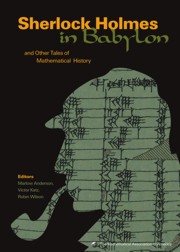Book contents
- Frontmatter
- Introduction
- Contents
- Ancient Mathematics
- Medieval and Renaissance Mathematics
- The Seventeenth Century
- Foreword
- An Application of Geography to Mathematics: History of the Integral of the Secant
- Some Historical Notes on the Cycloid
- Descartes and Problem-Solving
- René Descartes' Curve-Drawing Devices: Experiments in the Relations Between Mechanical Motion and Symbolic Language
- Certain Mathematical Achievements of James Gregory
- The Changing Concept of Change: The Derivative from Fermat to Weierstrass
- The Crooked Made Straight: Roberval and Newton on Tangents
- On the Discovery of the Logarithmic Series and Its Development in England up to Cotes
- Isaac Newton: Man, Myth, and Mathematics
- Reading the Master: Newton and the Birth of Celestial Mechanics
- Newton as an Originator of Polar Coordinates
- Newton's Method for Resolving Affected Equations
- A Contribution of Leibniz to the History of Complex Numbers
- Functions of a Curve: Leibniz's Original Notion of Functions and Its Meaning for the Parabola
- Afterword
- The Eighteenth Century
- Index
- About the Editors
Functions of a Curve: Leibniz's Original Notion of Functions and Its Meaning for the Parabola
from The Seventeenth Century
- Frontmatter
- Introduction
- Contents
- Ancient Mathematics
- Medieval and Renaissance Mathematics
- The Seventeenth Century
- Foreword
- An Application of Geography to Mathematics: History of the Integral of the Secant
- Some Historical Notes on the Cycloid
- Descartes and Problem-Solving
- René Descartes' Curve-Drawing Devices: Experiments in the Relations Between Mechanical Motion and Symbolic Language
- Certain Mathematical Achievements of James Gregory
- The Changing Concept of Change: The Derivative from Fermat to Weierstrass
- The Crooked Made Straight: Roberval and Newton on Tangents
- On the Discovery of the Logarithmic Series and Its Development in England up to Cotes
- Isaac Newton: Man, Myth, and Mathematics
- Reading the Master: Newton and the Birth of Celestial Mechanics
- Newton as an Originator of Polar Coordinates
- Newton's Method for Resolving Affected Equations
- A Contribution of Leibniz to the History of Complex Numbers
- Functions of a Curve: Leibniz's Original Notion of Functions and Its Meaning for the Parabola
- Afterword
- The Eighteenth Century
- Index
- About the Editors
Summary
When the notion of a function evolved in the mathematics of the late seventeenth century, the meaning of the term was quite different from our modern set theoretic definition, and also different from the algebraic notions of the nineteenth century. The main conceptual difference was that curves were thought of as having a primary existence apart from any analysis of their numeric or algebraic properties. Equations did not create curves, curves gave rise to equations. When Descartes published his Geometry [10] in 1637, he derived for the first time the algebraic equations of many curves, but never once did he create a curve by plotting points from an equation. Geometrical methods for drawing each curve were always given first, and then by analyzing the geometrical actions involved in the curve drawing apparatus he would arrive at an equation that related pairs of coordinates (not necessarily at right angles to each other) [20]. Descartes used equations to create a taxonomy of curves [17].
This tradition of seeing curves as the result of geometrical actions continued in the work of Roberval, Pascal, Newton, and Leibniz. Descartes used letters to represent various lengths but did not create any specific system of names. Leibniz, who introduced the term function into mathematics [2], considered six different functions associated with a curve, i.e., line segments or lengths that could be determined from each point on a curve relating it to a given line or axis.
- Type
- Chapter
- Information
- Sherlock Holmes in BabylonAnd Other Tales of Mathematical History, pp. 292 - 296Publisher: Mathematical Association of AmericaPrint publication year: 2003



